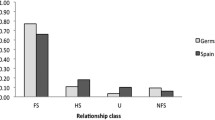Abstract
Genetic parentage studies of socially monogamous birds reveal a widespread prevalence of extra-pair paternity. Variation in extra-pair paternity among individuals may depend on how different individuals benefit from extra-pair fertilisations and on the opportunity to pursue extra-pair copulations. A long-term study of sand martins (Riparia riparia) in Hungary allowed us to examine patterns of extra-pair fertilisations in a large colony of over 3,000 breeding pairs with many known age individuals. We used multi-locus DNA fingerprinting to determine whether extra-pair fertilisations occur when females are paired to (1) presumably low quality mates, or (2) genetically similar or dissimilar mates, and whether extra-pair fertilisations result in offspring of higher quality. Extra-paternal young were found in 38% of 47 broods and comprised 19% of 190 offspring. Males that lost paternity did not differ significantly from others in age or body condition. Social mates of broods containing extra-pair offspring did not differ in genetic similarity from pairs without extra-pair offspring. Furthermore, there was no significant difference in body condition between extra-pair young and their maternal half-siblings. We were unable to assign paternity and therefore cannot exclude the possibility that extra-pair males differed from the within-pair males they cuckolded, in age, body condition or genetic similarity with the female. We found a positive relationship between paternity losses and breeding density, suggesting that low breeding density may constrain opportunities for seeking extra-pair copulations.




Similar content being viewed by others
References
Alves MAS, Bryant DM (1998) Brood parasitism in the sand martin, Riparia riparia: evidence for two parasitic strategies in a colonial passerine. Anim Behav 56:1323–1331
Aviv A (2002) Chronology versus biology—telomeres, essential hypertension, and vascular aging. Hypertension 40:229–232
Bateson P (1983) Optimal outbreeding. In: Bateson P (ed) Mate choice. Cambridge University Press, Cambridge, pp 257–277
Beecher MD, Beecher IM (1979) Sociobiology of bank swallows—reproductive strategy of the male. Science 205:1282–1285
Birkhead TR, Møller AP (1992) Sperm competition in birds. Evolutionary causes and consequences. Academic, London
Bjørnstad G, Lifjeld JT (1997) High frequency of extra-pair paternity in a dense and synchronous population of willow warblers Phylloscopus trochilus. J Avian Biol 28:319–324
Blomqvist D, Andersson M, Küpper C, Cuthill IC, Kis J, Lanctot RB, Sandercock BK, Székely T, Wallander J, Kempenaers B (2002) Genetic similarity between mates and extra-pair parentage in three species of shorebirds. Nature 419:613–615
Bouwman KM, Komdeur J (2005) Old female reed buntings (Emberiza schoeniclus) increase extra-pair paternity in their broods when mated to young males. Behaviour 142:1449–1463
Bouwman KM, Burke T, Komdeur J (2006a) How female reed buntings benefit from extra-pair mating behaviour: testing hypotheses through patterns of paternity in sequential broods. Mol Ecol 15:2589–2600
Bouwman KM, Burke T, Komdeur J (2006b) Older male reed buntings are more successful at gaining within- and extra-pair fertilizations. Anim Behav (in press)
Brooks R, Kemp DJ (2001) Can older males deliver the good genes? Trends Ecol Evol 16:308–313
Charmantier A, Perret P (2004) Manipulation of nest-box density affects extra-pair paternity in a population of blue tits (Parus caeruleus). Behav Ecol Sociobiol 56:360–365
Charmantier A, Blondel J, Perret P, Lambrechts MM (2004) Do extra-pair paternities provide genetic benefits for female blue tits Parus caeruleus? J Avian Biol 35:524–532
Dietrich V, Schmoll T, Winkel W, Epplen JT, Lubjuhn T (2004) Pair identity—an important factor concerning variation in extra-pair paternity in the coal tit (Parus ater). Behaviour 141:817–835
Eimes JA, Parker PG, Brown JL, Brown ER (2005) Extrapair fertilization and genetic similarity of social mates in the Mexican jay. Behav Ecol 16:456–460
Foerster K, Delhey K, Johnsen A, Lifjeld JT, Kempenaers B (2003) Females increase offspring heterozygosity and fitness through extra-pair matings. Nature 425:714–717
Greene E, Lyon BE, Muehter VR, Ratcliffe L, Oliver SJ, Boag PT (2000) Disruptive sexual selection for plumage coloration in a passerine bird. Nature 407:1000–1003
Griffith SC, Owens IPF, Thuman KA (2002) Extra pair paternity in birds: a review of interspecific variation and adaptive function. Mol Ecol 11:2195–2212
Haffer J (1985) Riparia. In: Glutz von Blotzheim UN, Bauer MB (eds) Handbuch der Vögel Mitteleuropas - Passeriformes (1.Teil). AULA, Wiesbaden, pp 315–366
Hansson B, Bensch S, Hasselquist D, Akesson M (2001) Microsatellite diversity predicts recruitment of sibling great reed warblers. Proc R Soc Lond B 268:1287–1291
Hasselquist D, Bensch S, vonSchantz T (1996) Correlation between male song repertoire, extra-pair paternity and offspring survival in the great reed warbler. Nature 381:229–232
Haussmann MF, Winkler DW, Vleck CM (2005) Longer telomeres associated with higher survival in birds. Biol Lett 1:212–214
Hoi H, Hoi-Leitner M (1997) An alternative route to coloniality in the bearded tit: females pursue extra-pair fertilizations. Behav Ecol 8:113–119
Johnsen A, Lifjeld JT, Andersson S, Ornborg J, Amundsen T (2001) Male characteristics and fertilisation success in bluethroats. Behaviour 138:1371–1390
Kania W (2001) Age determination of the great tit Parus major nestlings by means of the probability method based on feather development. Notatki Ornitol 42:117–138
Kempenaers B, Verheyren GR, Dhondt AA (1997) Extrapair paternity in the blue tit (Parus caeruleus): female choice, male characteristics, and offspring quality. Behav Ecol 8:481–492
Kleven O, Marthinsen G, Lifjeld JT (2006) Male extraterritorial forays, age and paternity in the socially monogamous reed bunting (Emberiza schoeniclus). J Ornithol 147:468–473
Kokko H (2001) Fisherian and “good genes” benefits of mate choice: how (not) to distinguish between them. Ecol Lett 4:322–326
Kokko H, Lindström J (1996) Evolution of female preference for old mates. Proc R Soc Lond B 263:1533–1538
Kokko H, Ots I (2006) When not to avoid inbreeding. Evolution 60:467–475
Krokene C, Anthonisen K, Lifjeld JT, Amundsen T (1996) Paternity and paternity assurance behaviour in the bluethroat, Luscinia s. svecica.Anim Behav 52:405–417
Manning JT (1985) Choosy females and correlates of male age. J Theor Biol 116:349–354
Marshall RC, Buchanan KL, Catchpole CK (2003) Sexual selection and individual genetic diversity in a songbird. Proc R Soc Lond B 270:S248–S250
Mays HL, Hill GE (2004) Choosing mates: good genes versus genes that are a good fit. Trends Ecol Evol 19:554–559
Møller AP, Brohede J, Cuervo JJ, de Lope F, Primmer C (2003) Extrapair paternity in relation to sexual ornamentation, arrival date, and condition in a migratory bird. Behav Ecol 14:707–712
Morton ES, Forman L, Braun M (1990) Extrapair fertilizations and the evolution of colonial breeding in purple martins. Auk 107:275–283
Pauliny A, Wagner RH, Augustin J, Szep T, Blomqvist D (2006) Age-independent telomere length predicts fitness in two bird species. Mol Ecol 15:1681–1687
Perry JN, Liebhold AM, Rosenberg MS, Dungan J, Miriti M, Jakomulska A, Citron-Pousty S (2002) Illustrations and guidelines for selecting statistical methods for quantifying spatial pattern in ecological data. Ecography 25:578–600
Petrie M, Kempenaers B (1998) Extra-pair paternity in birds: explaining variation between species and populations. Trends Ecol Evol 13:52–58
Pusey A, Wolf M (1996) Inbreeding avoidance in animals. Trends Ecol Evol 11:201–206
Rätti O, Hovi M, Lundberg A, Tegelström H, Alatalo RV (1995) Extra-pair paternity and male characteristics in the pied flycatcher. Behav Ecol Sociobiol 37:419–425
Richardson DS, Burke T (1999) Extra-pair paternity in relation to male age in Bullock’s orioles. Mol Ecol 8:2115–2126
Seddon N, Amos W, Mulder RA, Tobias JA (2004) Male heterozygosity predicts territory size, song structure and reproductive success in a cooperatively breeding bird. Proc R Soc Lond B 271:1823–1829
Seutin G, White BN, Boag PT (1991) Preservation of avian blood and tissue samples for DNA analyses. Can J Zool 69:82–90
Sheldon BC, Merilä J, Qvarnström A, Gustafsson L, Ellegren H (1997) Paternal genetic contribution to offspring condition predicted by size of male secondary sexual character. Proc R Soc Lond B 264:297–302
Shin HS, Bargiello TA, Clark BT, Jackson FR, Young MW (1985) An unusual coding sequence from a Drosophila clock gene is conserved in vertebrates. Nature 317:445–448
Siegel S, Castellan NJJ (1988) Nonparametric statistics for the behavioral sciences. McGraw-Hill, New York
Slagsvold T, Lifjeld JT (1997) Incomplete female knowledge of male quality may explain variation in extra-pair paternity in birds. Behaviour 134:353–371
Stutchbury BJM (1998) Female mate choice of extra-pair males: breeding synchrony is important. Behav Ecol Sociobiol 43:213–215
Sundberg J, Dixon A (1996) Old, colourful male yellowhammers, Emberiza citrinella, benefit from extra-pair copulations. Anim Behav 52:113–122
Svensson S (1969) Häckningsbiologiska studier i en koloni av backsvala, Riparia riparia,vid Ammarnäs år 1968. Fagelvarld 8:236–240
Szép T (1992) Nine year old sand martin (Riparia riparia) recovery in Eastern Hungary. Aquila 99:189
Szép T (1999) Effects of age- and sex-biased dispersal on the estimation of survival rates of the sand martin Riparia riparia population in Hungary. Bird Study 46:169–177
Szép T, Møller AP (1999) Cost of parasitism and host immune defence in the sand martin Riparia riparia: a role for parent–offspring conflict? Oecologia 119:9–15
Szép T, Szabó ZD, Vallner J (2003) Integrated population monitoring of sand martin Riparia riparia—an opportunity to monitor the effects of environmental disasters along the river Tisza. Ornis Hung 12–13:169–182
Tarof SA, Ratcliffe LM, Kasumovic MM, Boag PT (2005) Are least flycatcher (Empidonax minimus) clusters hidden leks? Behav Ecol 16:207–217
Tarvin KA, Webster MS, Tuttle EM, Pruett-Jones S (2005) Genetic similarity of social mates predicts the level of extrapair paternity in splendid fairy-wrens. Anim Behav 70:945–955
Tregenza T, Wedell N (2000) Genetic compatibility, mate choice and patterns of parentage: invited review. Mol Ecol 9:1013–1027
Trivers RL (1972) Parental investment and sexual selction. In: Campbell B (eds) Sexual selection and the descent of man: 1871–1971. Aldine, Chicago, pp 136–179
Wagner RH (1993) The pursuit of extra-pair copulations by female birds—a new hypothesis of colony formation. J Theor Biol 163:333–346
Wagner RH, Schug MD, Morton ES (1996) Confidence of paternity, actual paternity and parental effort by purple martins. Anim Behav 52:123–132
Westneat DF (1992) Do female red-winged blackbirds engage in a mixed mating strategy. Ethology 92:7–28
Westneat DF (1993) Polygyny and extrapair fertilizations in Eastern red-winged blackbirds (Agelaius–Phoeniceus). Behav Ecol 4:49–60
Westneat DF, Sherman PW (1997) Density and extra-pair fertilizations in birds: a comparative analysis. Behav Ecol Sociobiol 41:205–215
Westneat DF, Stewart IRK (2003) Extra-pair paternity in birds: causes, correlates, and conflict. Annu Rev Ecol Syst 34:365–396
Wetton JH, Carter RE, Parkin DT, Walters D (1987) Demographic-study of a wild house sparrow population by DNA fingerprinting. Nature 327:147–149
Zeh JA, Zeh DW (1996) The evolution of polyandry I: intragenomic conflict and genetic incompatibility. Proc R Soc Lond B 263:1711–1717
Zeh JA, Zeh DW (1997) The evolution of polyandry II: post-copulatory defences against genetic incompatibility. Proc R Soc Lond B 264:69–75
Acknowledgments
We thank Jan Lifjeld, Johan Wallander, Erwin Nemeth and two anonymous referees for constructive comments on the manuscript. Tibor Szép was supported by OTKA Grants T29853 and T42879. We also thank the Nyíregyháza Chapter of the MME/BirdLife Hungary for providing tools for the field work, and Noémi Szállassy, Béla Habarics and volunteers of the MME/BirdLife Hungary for assistance in the survey and ringing work. Finally, a very big thank you to Gaute Grønstøl for fruitful discussions and help with the manuscript. Collection of blood samples adhered to the national legal requirements for research with animals (permit number: Hungary, HNP/1873-2/2002).
Author information
Authors and Affiliations
Corresponding author
Additional information
Communicated by M. Wink.
Rights and permissions
About this article
Cite this article
Augustin, J., Blomqvist, D., Szép, T. et al. No evidence of genetic benefits from extra-pair fertilisations in female sand martins (Riparia riparia). J Ornithol 148, 189–198 (2007). https://doi.org/10.1007/s10336-006-0119-8
Received:
Revised:
Accepted:
Published:
Issue Date:
DOI: https://doi.org/10.1007/s10336-006-0119-8




